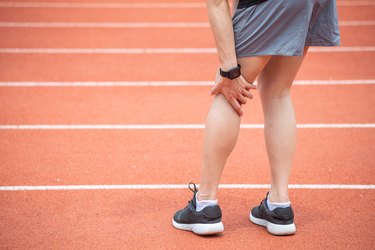
If you've noticed twinges of pain behind your kneecap, you're not alone — it's a common complaint that affects people of all ages and activity levels. While there's no single reason for this discomfort, there are a few common injuries and conditions you should know about.
Patellofemoral Syndrome
Video of the Day
"The most common cause of pain behind the kneecap is patellofemoral syndrome," says Audrey Lynn Millar, PT, PhD, professor and chair of the Department of Physical Therapy at Winston-Salem State University in North Carolina.
Video of the Day
According to the American Academy of Orthopaedic Surgeons (AAOS), patellofemoral pain syndrome is actually an umbrella term that encompasses pain experienced in the front of the knee and in the area around the kneecap (technically called the patella). The condition is sometimes called "runner's knee" or "jumper's knee," says AAOS, and according to the Cleveland Clinic, it can occur in anyone but is most common in females and athletes.
"There have been many different theories throughout the years as to the cause and treatment," Dr. Millar says of patellofemoral pain syndrome. "Most of the current research suggests a combination of a lack of muscular control at the hip, which allows the knee to move too medially (toward the middle) during landing or stance." This motion can put stress on the joint, and it may make your knee hurt more when you're walking down stairs or sitting for a long period of time, she says.
To treat patellofemoral pain syndrome, AAOS says that the "RICE" method can help — RICE being the acronym for rest, ice, compression (wrapping the knee snugly) and elevation (resting with your knee positioned higher than your heart). Anti-inflammatory drugs like ibuprofen (Advil) or naproxen (Aleve) can also help.
Dr. Millar adds that strengthening your hip muscle can also help, as can special shoes or orthotics. A physical therapist can teach you specific exercises to help with this, AAOS says.
Pain behind the kneecap may be related to a specific injury, including a sprained ligament or torn cartilage, according to Johns Hopkins Medicine. A sudden twist of your knee can cause a sprained muscle or ligament, and trauma to your knee can tear the meniscus, which is the connective tissue in your knee.
If your pain is rooted in a torn meniscus, it's usually accompanied by swelling in your knee, a clicking or locking feeling or an overall unstable feeling, according to Cedars-Sinai. Your doctor can officially diagnose a torn meniscus using an X-ray or an MRI or by inserting a small tube, called an arthroscope, during a minimally invasive procedure and looking through the scope to evaluate the knee joint and surrounding tissue.
Treating a knee injury like a torn meniscus may require wearing a brace during activity or possibly undergoing surgery if the injury is severe, according to Johns Hopkins.
Chronic Conditions
Conditions such as arthritis and infections can also cause knee pain, according to the Mayo Clinic. The most common type of arthritis, osteoarthritis, occurs when the cartilage in your knee deteriorates, usually from use and age. Osteoarthritis can lead to increasing pain if it isn't treated, the Mayo Clinic states. In other words, it's a good idea to loop in your doctor.
According to Johns Hopkins, tendon inflammation, known as tendonitis, may also be the reason for your knee pain. It can result from overusing your tendons while running, cycling or jumping, and basketball is a common cause.
What to Do
Treating behind-the-knee pain can involve many different approaches, depending on your specific injury or condition. In terms of prevention, the Mayo Clinic offers a few general recommendations:
- Maintain a healthy weight.
- Condition your muscles for your specific sport.
- Stretch often to remain flexible.
- Choose low-impact activities, such as swimming or water aerobics, if you know you have chronic knee pain.
Read more: Bad Knees? Try These 14 Knee-Strengthening Exercises
- Audrey Lynn Millar, PT, PhD, professor, chair, Department of Physical Therapy, Winston-Salem State University, North Carolina
- American Academy of Orthopaedic Surgeons: “Patellofemoral Pain Syndrome”
- Cleveland Clinic: “4 Questions That Help Solve Your Knee Pain Mystery”
- Johns Hopkins Medicine: “Knee Pain and Problems”
- Mayo Clinic: “Knee Pain”
- Cedars-Sinai: “Torn Meniscus”
Is this an emergency? If you are experiencing serious medical symptoms, please see the National Library of Medicine’s list of signs you need emergency medical attention or call 911.